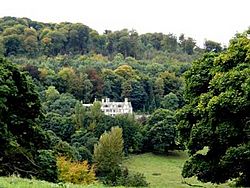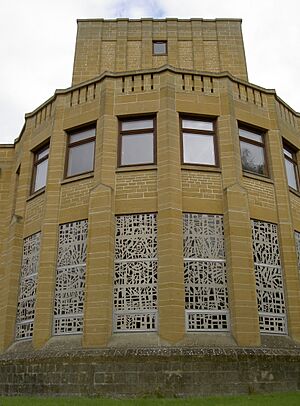Prinknash Abbey facts for kids

St Peter's Grange, Prinknash Abbey
|
|
| Monastery information | |
|---|---|
| Order | Benedictine, Subiaco Congregation |
| Established | 681 at Gloucester as St. Peter's Abbey |
| Disestablished | 1539 |
| Reestablished | 1928 |
| Mother house | Benedictine monks of Caldey Island |
| Diocese | Diocese of Clifton (Roman Catholic Church) |
| People | |
| Founder(s) | Abbot Serlo (1072–1104), re-founded under Ælred Carlyle (1928) |
| Important associated figures | Dom Bede Griffiths, Ælred Carlyle, Stephen Horton |
Prinknash Abbey is a Roman Catholic monastery located in the beautiful Vale of Gloucester. It is near the village of Cranham in England. This abbey is part of the worldwide Benedictine family of monasteries. Prinknash Abbey is especially known for making incense, and it is actually the biggest incense maker in Europe!
Contents
The History of Prinknash Abbey
For almost 900 years, the land where Prinknash Abbey stands has been connected to Benedictine monks.
Early Beginnings
Around the year 1096, a family called Giffard gave this land to Serlo. He was the Abbot of Saint Peter's in Gloucester. A large part of the main building you see today was built around 1520. This was during the time of William Parker, who was the last Abbot of Gloucester.
Changes Over Time
The abbey stayed with the monks until 1539. This was when King Henry VIII closed down many monasteries in England. Prinknash was then rented out to Sir Anthony Kingston. He had to give 40 deer to the King every year! King Henry VIII used the house as a place to stay when he went hunting. For many centuries after that, Prinknash Park was a home for important families in Gloucestershire. Each family added their own touch to the property.
The Monks Return
On August 1, 1928, the Earl of Rothes decided to give Prinknash to the Benedictine monks. These monks had come from Caldey Island. They had changed from being Anglican to Roman Catholic in 1913. Their leader was Abbot Ælred Carlyle.
Caldey Island was later sold to another group of monks called the Cistercians. So, on October 26, 1928, six Benedictine monks arrived from Caldey Island to turn the house at Prinknash into a monastery. More monks soon joined them. After some difficult years, they managed to buy all the land around the house. This is how Prinknash became what it is today.
Growing and Moving
The community of monks at Prinknash grew, starting with 25 monks. Today, there are 9 monks at Prinknash itself. Other monks from Prinknash have helped start new monasteries. One was started at Farnborough in 1947, and another at Pluscarden in Scotland later that same year.
In 1939, a special stone was laid for a new abbey building at Prinknash. This was done by Cardinal Hinsley. However, the Second World War started, and the building plans had to be changed. The monks finally moved into the new abbey in 1972.
The old abbey building was then fixed up and turned into a retreat and conference center. It is now known as "St Peter's Grange." However, by 2008, the community of monks had become smaller. They decided to move back to St Peter's Grange. This move happened on June 30, which is the Feast of Saints Peter and Paul.
Daily Life at Prinknash Abbey
The monks at Prinknash Abbey follow a daily schedule of prayer. This schedule includes special prayer times called canonical hours.
Mass and Prayer
From Monday to Saturday, the monks pray Mass at 8:30 in the morning. On Sundays, they celebrate Mass at 9:00 in the morning. They also have another Mass at 11:00 AM. Because of the COVID-19 pandemic in the United Kingdom, the Sunday Masses are not currently open to the public.
Art at Prinknash Abbey
Monks at Prinknash have also contributed to art. In 1972 and 1973, a monk named Brother Patrick helped design and create several items for Clifton Cathedral in Bristol.
Artistic Contributions
Brother Patrick designed the beautiful votive candelabra that hangs in the Lady Chapel. It is made from twenty stainless steel triangles. He also created the decorative screens for the Blessed Sacrament Chapel.


